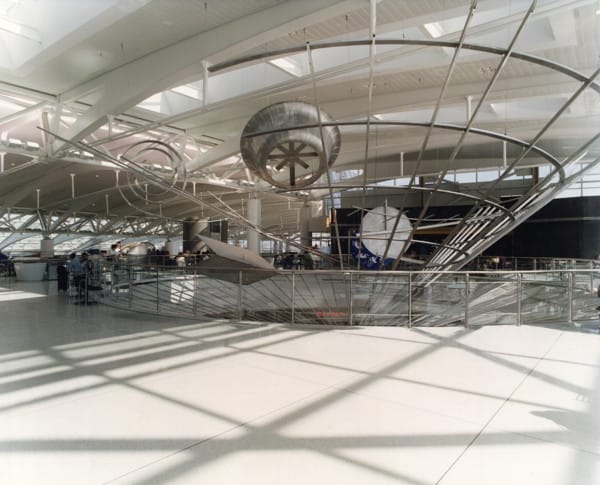Food Court Threatens Alice Aycock Sculpture at JFK
Oy! The Terminal One Group Association (TOGA) at JFK airport wants to dismantle and remove a work inside that terminal, "Star Sifter," by renowned American sculptor Alice Aycock.

Airport sculptures comprise an underappreciated category of public art. We don’t talk about them very much, but they serve a very specific artistic and social function: helping us pass and alleviate the often nervous, never-ending wait before a flight.
So it’s dismaying news that the Terminal One Group Association (TOGA) at JFK airport wants to dismantle and remove a work inside that terminal, “Star Sifter,” by renowned American sculptor Alice Aycock. And the reason? No, it’s not to make space for more security checkpoints and full-body scanners — no, they want to add more food concessions.
Aycock and her lawyers filed a complaint yesterday to stop TOGA from removing the sculpture, which it had planned to do this Wednesday, April 25. The district court judge issued a restraining order the same day.
The worst part is that TOGA — whose partners include Air France, Japan Air Lines, Korean Air and Lufthansa — actually commissioned “Star Sifter” 14 years ago. Aycock designed the work specifically for the space at Terminal one, and according to yesterday’s court complaint, it had both an artistic and practical function:
“Not only was the sculpture intended to enrich the terminal aesthetically, but it was also intended to fulfill a function purpose by filling an opening in the rotunda that created an unanticipated security risk in the building design.”
The original contract stipulates that the sculpture can be removed only if it is “required or necessary.”
Hyperallergic spoke with art lawyer Jo Backer Laird, a member of Aycock’s pro-bono team, who said:
“We think it’s a very strong case. As the complaint says, their proffered reason for taking the sculpture down is to be able to add a few more food concessions in an area that’s outside of security. And we think the words ‘necessary and required’ — they have to mean something if they’re in the agreement, and we don’t think that rises to the meaning of it.”
As if in confirmation of the the sketchiness of the whole affair, when TOGA first told Aycock of its plans to remove the sculpture, in a letter dated December 12, 2011, it didn’t offer an alternative for dismantling the sculpture or give a reason, only taking up the food-court defense later.
As per the original contract between Aycock and TOGA, Aycock has served the group with a demand for arbitration.




